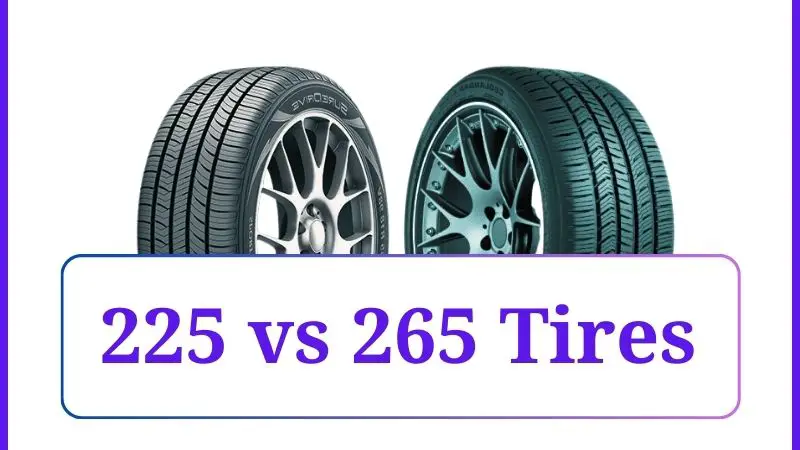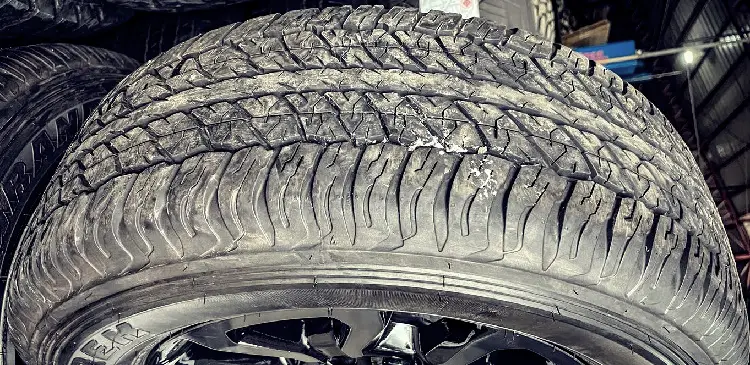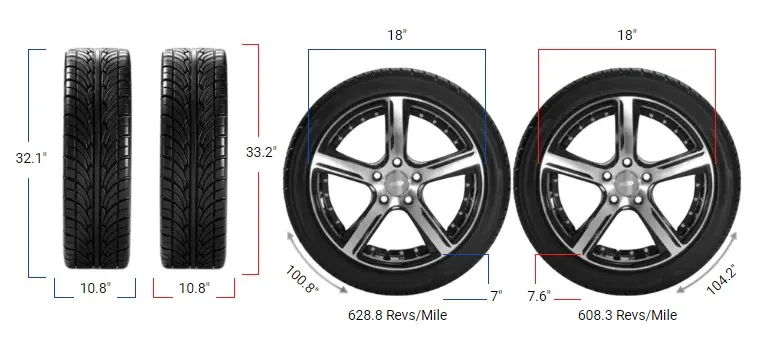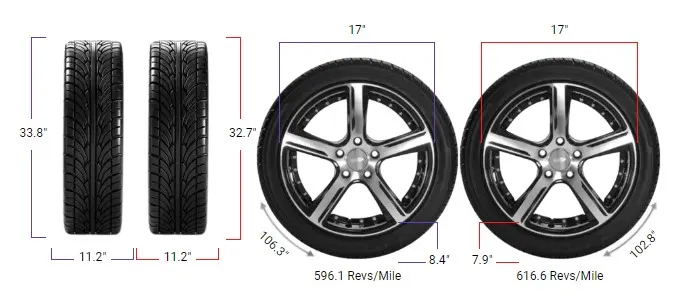225 vs 265 Tires

The biggest difference between 225 and 265 tires is their width. The 225 tire is 225 millimeters wide, while the 265 tire has a width of 265 millimeters. This extra 40 millimeters of width affects several aspects of your vehicle’s performance, including traction, fuel efficiency, and handling.
A wider tire, such as the 265, provides a larger contact patch with the road. This means more rubber is in contact with the road surface, which can improve traction and cornering stability.
The increased traction makes 265 tires a popular choice for drivers looking for better grip, especially in dry conditions or during high-speed driving. However, the extra width also means increased rolling resistance, which can lead to lower fuel efficiency compared to 225 tires.
On the other hand, the 225 tire is narrower and provides a smaller contact patch. This typically results in lower rolling resistance, which helps improve fuel efficiency. 225 tires also tend to have a lighter feel, which can make them easier to handle, particularly in urban settings where maneuverability is important.

Fitment Guide
Before deciding to switch between 225 and 265 tires, it’s important to make sure the new size is compatible with your vehicle’s rim width. Here is how the Ideal Rim Width Range applies:
- The 225 tire fits rims that are 7.0 to 8.0 inches wide.
- The 265 tire fits rims that are 8.5 to 9.5 inches wide.
Since the 225 and 265 tires do not share an overlapping rim width range, switching from 225 to 265 will not recommended without ensure proper fitment.
On-Road Performance
Handling and Stability: The 265 tire, being wider, offers improved handling and stability due to the larger contact patch. This increased grip is particularly noticeable when cornering or during high-speed driving, where the wider footprint helps keep the vehicle stable and reduces the likelihood of slipping.
For those who enjoy a more dynamic driving experience or need extra confidence in sharp turns, 265 tires provide a significant advantage.
However, 225 tires also have their benefits. With their narrower profile, they offer lighter steering and greater maneuverability, making them ideal for urban environments. The reduced rolling resistance also means the vehicle is easier to handle in tight situations, such as parking or making quick lane changes in city traffic.
Fuel Efficiency: One of the key advantages of 225 tires is their better fuel efficiency. The narrower width creates less friction with the road, which means less energy is required to keep the vehicle moving.
This can result in significant fuel savings over time, especially for drivers who spend a lot of time commuting or driving long distances. On the other hand, 265 tires have more rolling resistance due to their larger contact area, which can lead to a decrease in fuel economy.

Ride Comfort: In terms of ride comfort, 265 tires generally provide a smoother ride because the larger contact area helps absorb bumps and imperfections in the road.
This can enhance the overall driving experience, particularly on rough roads or highways. However, 265 tires may also produce more road noise compared to 225 tires, especially at higher speeds.
225 tires offer a more predictable and comfortable ride, especially for everyday city driving. The narrower tires generate less noise and can provide a slightly firmer feel, which some drivers may prefer for its responsiveness.
Off-Road Performance
Traction on Loose Surfaces: If you plan on taking your vehicle off-road, 265 tires can offer significant advantages. The wider footprint of the 265 tire provides better traction on loose surfaces like sand, gravel, or mud, making it ideal for off-road conditions where extra grip is needed.
This added traction can help prevent the vehicle from getting stuck in soft terrain and offers more stability when navigating uneven surfaces. 225 tires, on the other hand, can be more effective in situations where precision is key.
The narrower profile allows the tire to dig into loose surfaces more effectively, providing better control in specific off-road scenarios, such as navigating rocky trails. For drivers who need better maneuverability rather than pure grip, 225 tires may be the preferred option.

Speedometer Impact
Switching from 225 to 265 tires can impact your vehicle’s speedometer and odometer readings. The overall diameter of the tire might change, depending on the aspect ratio and rim size. If the 265 tire has a larger overall diameter than the 225 tire, your speedometer may display a speed that is lower than your actual speed, leading to inaccuracies.
To maintain accurate speed and distance measurements, it may be necessary to recalibrate the speedometer if the diameter difference exceeds the 3% limit. This ensures that your vehicle’s performance remains consistent and that you’re getting reliable information while driving.
Benefits of 265 Tires:
- Better Traction and Stability: The wider contact patch provides enhanced grip, especially during cornering and in dry conditions.
- Off-Road Performance: The larger footprint offers better flotation and traction on loose surfaces, making 265 tires ideal for off-road use.
- Aggressive Look: 265 tires give the vehicle a more muscular and sporty appearance, which many drivers find appealing.
Drawbacks of 265 Tires:
- Lower Fuel Efficiency: The increased rolling resistance of 265 tires results in lower fuel efficiency compared to 225 tires.
- Fitment Challenges: Switching to 265 tires may require new rims, and the larger size could lead to clearance issues depending on your vehicle’s wheel wells.
Benefits of 225 Tires:
- Better Fuel Economy: The narrower width means less rolling resistance, which helps improve fuel efficiency, making 225 tires a great option for those focused on economy.
- Easy Handling: 225 tires are easier to steer, especially in tight city environments where maneuverability is important.
- Quieter Ride: With a smaller contact patch, 225 tires generally produce less road noise, contributing to a more comfortable driving experience.
Drawbacks of 225 Tires:
- Less Traction: Compared to 265 tires, 225 tires have a smaller contact area, which can reduce traction, especially in high-speed cornering or on loose surfaces.
- Less Aggressive Appearance: The narrower width may not provide the sporty look that some drivers prefer.

Difference Between 225 and 265 Tires
The main difference between 225 and 265 tires is the width; 265 tires are 40mm wider than 225 tires, affecting handling, stability, and overall vehicle performance. Wider tires may offer better traction but require wider rims and can impact fuel efficiency.
Can I Use 225 Tires Instead of 265?
Using 225 tires instead of 265 is not recommended because their ideal rim width ranges do not overlap.
The 225 tires fit rims 6.5 to 8.0 inches wide, while 265 tires require rims 8.5 to 10.0 inches. Switching without changing rims can lead to improper fitment and safety issues.
Can I Use 265 Tires Instead of 225?
No, you should not use 265 tires instead of 225 without changing rims. The 265 tires need rims 8.5 to 10.0 inches wide, whereas 225 tires fit rims 6.5 to 8.0 inches.
Mounting wider tires on narrower rims can cause handling problems and pose safety risks.
Can You Put 225 Tires on 265 Rims?
No, installing 225 tires on rims designed for 265 tires is inadvisable. The 225 tires are suitable for rims 6.5 to 8.0 inches wide, but 265 rims are 8.5 to 10.0 inches.
Using narrower tires on wider rims can lead to poor tire seating and increased risk of tire failure.
Can You Put 265 Tires on 225 Rims?
No, you should not put 265 tires on rims intended for 225 tires. The 265 tires require rims 8.5 to 10.0 inches wide, while 225 rims are 6.5 to 8.0 inches.
Mounting wider tires on narrower rims can cause sidewall stress and potential tire blowouts, posing safety hazards.

How will switching to 265 tires affect my fuel efficiency?
265 tires have greater rolling resistance, which may lead to reduced fuel efficiency compared to 225 tires.
Will 265 tires improve my vehicle’s off-road performance?
Yes, the wider 265 tires provide a larger contact patch, which enhances traction and stability on loose surfaces like gravel and sand.
Do I need to recalibrate my speedometer if I switch from 225 to 265 tires?
If the overall diameter changes by more than 3%, recalibration may be necessary to maintain accurate speedometer and odometer readings.
Our Observation
In our observation, Switching to 265 tire is not recommended as the tire width range not overlap. If you still switching from 225 tire to 265 then leveling up kit should be necessary to fit perfectly and avoid clearness issue.
The choice between 225 and 265 tires depends largely on what you need from your vehicle. If fuel efficiency, maneuverability, and a quiet ride are your priorities, then 225 tires are likely the better option.
However, if you’re looking for better stability, off-road capability, and a more aggressive look, 265 tires might be the ideal choice.
Always remember to check rim compatibility and overall diameter differences before making a switch to ensure safety and performance.



